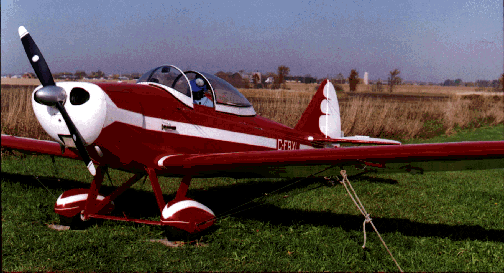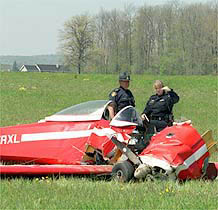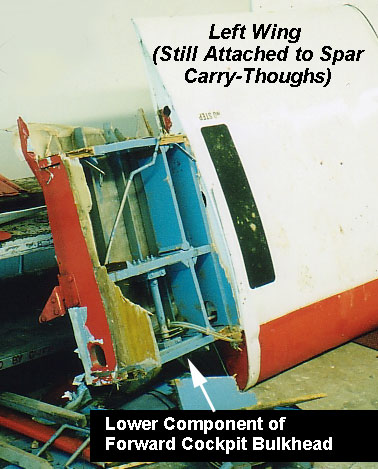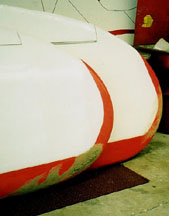 Chris Horsten
has reported the crash of his father's Fly Baby, with his father at the
controls. While he is expected to recover, the aircraft is
a total loss.
Chris Horsten
has reported the crash of his father's Fly Baby, with his father at the
controls. While he is expected to recover, the aircraft is
a total loss.
 Chris Horsten
has reported the crash of his father's Fly Baby, with his father at the
controls. While he is expected to recover, the aircraft is
a total loss.
Chris Horsten
has reported the crash of his father's Fly Baby, with his father at the
controls. While he is expected to recover, the aircraft is
a total loss.
Chris has been kind enough to send me some pictures taken after the
accident, and some of his impressions of what happened. I've inserted
a couple of comments in italics.
 While waiting
to be rescued, he undid the turnbuckle to relieve pressure on his legs.
It did not help. I spoke with him this evening and he said he would no
longer feel safe flying the Flybaby. We have another almost complete and
he thinks he will sell it as soon as it is done. He said he would not want
to be stuck in a remote area, and not be able to get out. Perhaps the verticals
of that station need to be reinforced? Food for thought for other Flybaby
drivers.
While waiting
to be rescued, he undid the turnbuckle to relieve pressure on his legs.
It did not help. I spoke with him this evening and he said he would no
longer feel safe flying the Flybaby. We have another almost complete and
he thinks he will sell it as soon as it is done. He said he would not want
to be stuck in a remote area, and not be able to get out. Perhaps the verticals
of that station need to be reinforced? Food for thought for other Flybaby
drivers.
[Being trapped in the wreckage after a crash is a concern to any pilot. As you'll see in the follow-up information and photos that Chris sent, this Fly Baby underwent an extreme impact. The entire fuselage forward of the front cockpit bulkhead was torn off. Reinforcement of the forward cockpit bulkhead may have helped, but on light aircraft like Fly Babies, I'm not sure how effective it would be. -RJW]
Follow-up message a few days later:
Had another
look at the wreck. The top of the bulkhead did not fail. In fact, my father
was able to loosen off the turnbuckle thinking it would release some of
the pressure on his legs. It did not. The rescue guys used some nearby
stakes in the ground and a crowbar to pry it apart. So I think it was the
bottom member that failed. I don't know what broke his leg specifically.
When I arrived on the scene he was already taken to hospital. I found the
fuel tank outside the aircraft (ruptured) and everything ahead of the panel
bulkhead missing. The engine had taken the bulk of the load, crumpling
the engine mount and snapping of the mags.
The firewall was broken backwards. It also broke away from the fuse, taking everything except the bulkhead below the panel with it. The glareshield was intact but the windshield was not. The toe brakes which are each a self contained unit broke right out still attached to the center support they were attached too. The square area beneath the seat with the spar carry through and control linkages became detached from the fuse as well. On lifting the fuse up to remove it, it easily separated and remained attached to the wings.
[Examining the picture of the fuselage reveals some good details. The bottom member of the forward cockpit bulkhead obviously failed..and if you look carefully at the vertical members, they're gone too (the one on the lft in the picture looks like it's there, but you can see a break mark just above the bare wood half-way down. It looks like it sprung back into position due to the plywood remaining on the outside of the fuselage.).
Normally, a bulkhead like this would be reinforced by a diagonal brace. But this isn't possible, since the pilot's body sticks through this opening. To compensate for this, each corner of the bulkhead is reinforced with quarter-round gussets. The picture shows the verticals failed exactly where one would expect them to: just past the quarter-round gussets. If one wanted to reinforce this section, you could increase the size of the vertical members and possibly make the gussets a bit larger. But that will cut into the pilot space, and I'm not sure if it would help...it's obvious this airplane took a heck of a knock. The firewall itself failed, and it's a solid sheet.
 What happened
to the lower part of the forward cockpit bulkhead? The next picture
shows it: That lower part is also the forward spar carry-through,
and it stayed with the wing. - RJW]
What happened
to the lower part of the forward cockpit bulkhead? The next picture
shows it: That lower part is also the forward spar carry-through,
and it stayed with the wing. - RJW]
 My dad's Baby
had the rear spar carry through mod. Considering the incredible force
on the wing tips when they each hit during the cart wheel, they have remained
intact. Those laminated tips are VERY strong. In fact, without stripping
the wings, it will be hard to figure out if there is any damage at all
to the wings.
My dad's Baby
had the rear spar carry through mod. Considering the incredible force
on the wing tips when they each hit during the cart wheel, they have remained
intact. Those laminated tips are VERY strong. In fact, without stripping
the wings, it will be hard to figure out if there is any damage at all
to the wings.
[While the wingtip bows are strong, I don't think they are THAT strong. I wonder about the reports that it cartwheeled...perhaps, instead, it hit flat enough that the landing gear took the majority of the impact. This may be consistent with the failure at the forward cockpit bulkhead. If the gear hit first and failed (note how the gear tore loose in the fuselage photo above-the gear is propped against the back wall), it would provide a tremendous jerk DOWNWARDS on the wing via the flying and landing wires. This would transmit a lot of force to the bulkhead. Still, I think the wires would fail before the bulkhead crushed solely from their tension.
But I'm no structures engineer. Once the firewall got ripped off the airplane, I think all bets were off as to whether the bulkhead would survive. - RJW]
However, in a follow-up comment, Chris feels the plane definitely cartwheeled:
There are only three marks on the ground aside from where it came to rest. Two are wing tips and one in the middle is bigger and messier, the engine. See photo of wing tips for corresponding dirt too. The ground was pretty soft so the tips left impressions a foot deep.
(Photos by Chris Horsten)
Comments? Contact Ron Wanttaja.